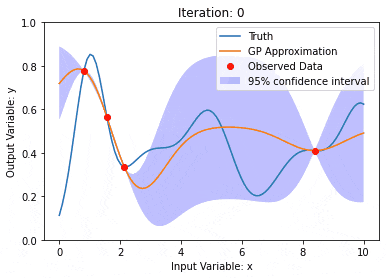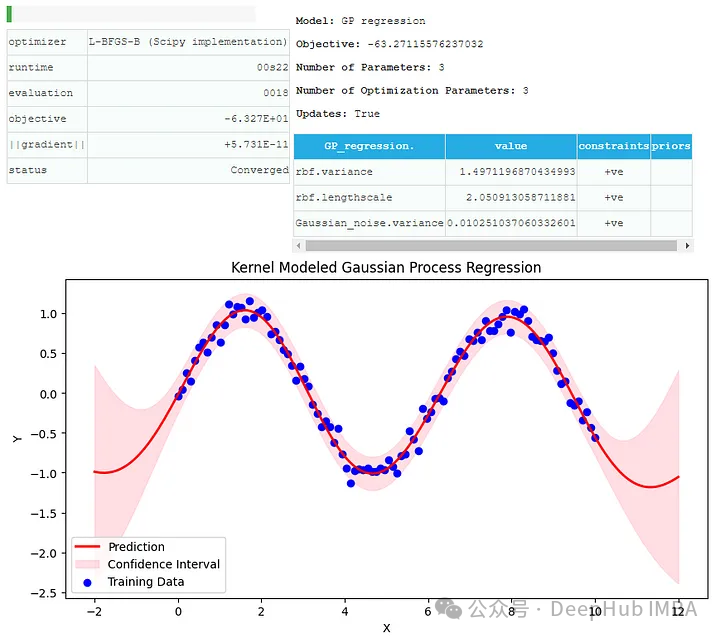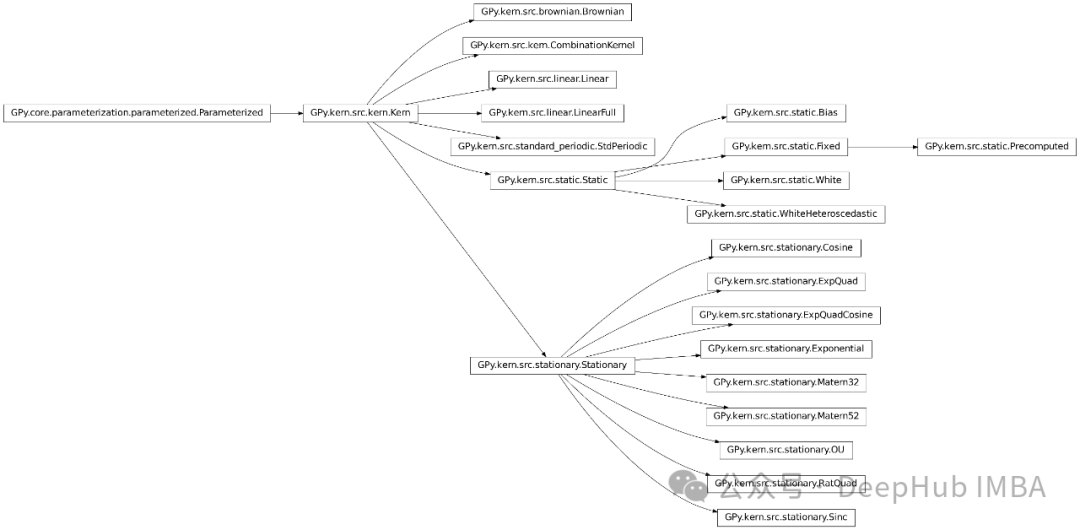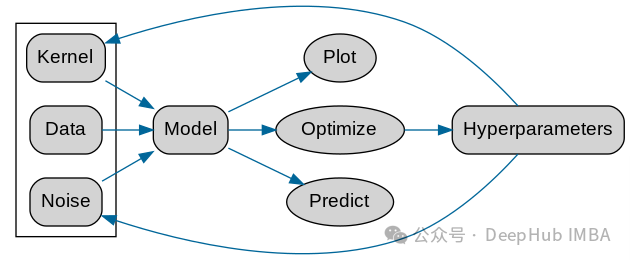Data modeling using Kernel Model Gaussian Processes (KMGPs)
Kernel Model Gaussian Processes (KMGPs) are sophisticated tools for handling the complexity of various data sets. It extends the concept of traditional Gaussian processes through kernel functions. This article will discuss in detail the theoretical basis, practical applications and challenges of KMGPs.
The kernel model Gaussian process is an extension of the traditional Gaussian process and is used in machine learning and statistics. Before understanding kmgp, you need to master the basic knowledge of Gaussian process, and then understand the role of the kernel model.

Gaussian processes (GPs)
The Gaussian process is a set of random variables, and a finite number of variables are combined with Gaussian Distribution, used to define function probability distributions.
The Gaussian process is commonly used in regression and classification tasks in machine learning and can be used to fit the probability distribution of data.
An important characteristic of Gaussian processes is the ability to provide uncertainty estimates and predictions, which is very useful in the task of understanding the confidence of the predictions is as important as the predictions themselves.
Kernel function modeling
In the Gaussian process, the kernel function (or covariance function) is used to measure the differences between different data points similarity. The kernel function takes two inputs and calculates the similarity score between them.
There are various types of kernels such as linear, polynomial, and radial basis functions (RBF). Each core has different characteristics, and the appropriate core can be selected according to the problem.
In Gaussian processes, kernel modeling is the process of selecting and optimizing kernel functions to best capture the underlying patterns in the data. This step is very important because the choice and configuration of the kernel can significantly affect the performance of the Gaussian process.
Kernel Model Gaussian Processes (KMGPs)
KMGPs is an extension of the standard GP (Gaussian process), focusing on the application of kernel functions. Compared with standard GPs, KMGPs focus more on customizing complex or custom-designed kernel functions based on specific types of data or problems. This approach is particularly useful when the data is complex and standard kernel functions fail to capture the underlying relationships. However, designing and tuning kernel functions in KMGPs is challenging and often requires deep domain knowledge and professional experience in the problem domain and statistical modeling.
The kernel model Gaussian process is a sophisticated tool in statistical learning, providing a flexible and powerful way to model complex data sets. They are particularly valued for their ability to provide uncertainty estimates and their adaptability to reconcile different types of data through custom reconciliations.
Well-designed kernels in KMGP can model complex phenomena such as nonlinear trends, periodicity, and heteroskedasticity (varying noise levels) in the data. So it requires in-depth domain knowledge and a thorough understanding of statistical modeling.
KMGP has applications in many fields. In geostatistics, they model spatial data to capture underlying geographic variation. In finance, they are used to predict stock prices, explaining the unstable and complex nature of financial markets. In robotics and control systems, KMGPs model and predict the behavior of dynamic systems under uncertainty.
Code
We use the synthetic data set to create a complete Python code example. Here we use a library GPy, which is a specialized Library for handling Gaussian processes.
pip install numpy matplotlib GPy
Import library
import numpy as np import matplotlib.pyplot as plt import GPy
We will then create a synthetic dataset using numpy.
X = np.linspace(0, 10, 100)[:, None] Y = np.sin(X) + np.random.normal(0, 0.1, X.shape)
Define and train a Gaussian process model using GPy
kernel = GPy.kern.RBF(input_dim=1, variance=1., lengthscale=1.) model = GPy.models.GPRegression(X, Y, kernel) model.optimize(messages=True)
After training the model, we will use it to make predictions on the test data set. Then plot a graph to visualize the model's performance.
X_test = np.linspace(-2, 12, 200)[:, None] Y_pred, Y_var = model.predict(X_test) plt.figure(figsize=(10, 5)) plt.plot(X_test, Y_pred, 'r-', lw=2, label='Prediction') plt.fill_between(X_test.flatten(), (Y_pred - 2*np.sqrt(Y_var)).flatten(), (Y_pred + 2*np.sqrt(Y_var)).flatten(), alpha=0.5, color='pink', label='Confidence Interval') plt.scatter(X, Y, c='b', label='Training Data') plt.xlabel('X') plt.ylabel('Y') plt.title('Kernel Modeled Gaussian Process Regression') plt.legend() plt.show()
We apply the Gaussian process regression model with RBF kernel here, and you can see the prediction and training data and confidence interval.
Summary
The kernel model Gaussian process represents a major advance in the field of statistical learning, providing a flexible and powerful framework for understanding complex data sets. . GPy also contains basically all the kernel functions we can see. The following is a screenshot of the official document:

For different data You need to choose different kernel function kernel hyperparameters. Here GPy official also gives a flow chart

The above is the detailed content of Data modeling using Kernel Model Gaussian Processes (KMGPs). For more information, please follow other related articles on the PHP Chinese website!

Hot AI Tools

Undresser.AI Undress
AI-powered app for creating realistic nude photos

AI Clothes Remover
Online AI tool for removing clothes from photos.

Undress AI Tool
Undress images for free

Clothoff.io
AI clothes remover

AI Hentai Generator
Generate AI Hentai for free.

Hot Article

Hot Tools

Notepad++7.3.1
Easy-to-use and free code editor

SublimeText3 Chinese version
Chinese version, very easy to use

Zend Studio 13.0.1
Powerful PHP integrated development environment

Dreamweaver CS6
Visual web development tools

SublimeText3 Mac version
God-level code editing software (SublimeText3)

Hot Topics
 This article will take you to understand SHAP: model explanation for machine learning
Jun 01, 2024 am 10:58 AM
This article will take you to understand SHAP: model explanation for machine learning
Jun 01, 2024 am 10:58 AM
In the fields of machine learning and data science, model interpretability has always been a focus of researchers and practitioners. With the widespread application of complex models such as deep learning and ensemble methods, understanding the model's decision-making process has become particularly important. Explainable AI|XAI helps build trust and confidence in machine learning models by increasing the transparency of the model. Improving model transparency can be achieved through methods such as the widespread use of multiple complex models, as well as the decision-making processes used to explain the models. These methods include feature importance analysis, model prediction interval estimation, local interpretability algorithms, etc. Feature importance analysis can explain the decision-making process of a model by evaluating the degree of influence of the model on the input features. Model prediction interval estimate
 Identify overfitting and underfitting through learning curves
Apr 29, 2024 pm 06:50 PM
Identify overfitting and underfitting through learning curves
Apr 29, 2024 pm 06:50 PM
This article will introduce how to effectively identify overfitting and underfitting in machine learning models through learning curves. Underfitting and overfitting 1. Overfitting If a model is overtrained on the data so that it learns noise from it, then the model is said to be overfitting. An overfitted model learns every example so perfectly that it will misclassify an unseen/new example. For an overfitted model, we will get a perfect/near-perfect training set score and a terrible validation set/test score. Slightly modified: "Cause of overfitting: Use a complex model to solve a simple problem and extract noise from the data. Because a small data set as a training set may not represent the correct representation of all data." 2. Underfitting Heru
 Transparent! An in-depth analysis of the principles of major machine learning models!
Apr 12, 2024 pm 05:55 PM
Transparent! An in-depth analysis of the principles of major machine learning models!
Apr 12, 2024 pm 05:55 PM
In layman’s terms, a machine learning model is a mathematical function that maps input data to a predicted output. More specifically, a machine learning model is a mathematical function that adjusts model parameters by learning from training data to minimize the error between the predicted output and the true label. There are many models in machine learning, such as logistic regression models, decision tree models, support vector machine models, etc. Each model has its applicable data types and problem types. At the same time, there are many commonalities between different models, or there is a hidden path for model evolution. Taking the connectionist perceptron as an example, by increasing the number of hidden layers of the perceptron, we can transform it into a deep neural network. If a kernel function is added to the perceptron, it can be converted into an SVM. this one
 The evolution of artificial intelligence in space exploration and human settlement engineering
Apr 29, 2024 pm 03:25 PM
The evolution of artificial intelligence in space exploration and human settlement engineering
Apr 29, 2024 pm 03:25 PM
In the 1950s, artificial intelligence (AI) was born. That's when researchers discovered that machines could perform human-like tasks, such as thinking. Later, in the 1960s, the U.S. Department of Defense funded artificial intelligence and established laboratories for further development. Researchers are finding applications for artificial intelligence in many areas, such as space exploration and survival in extreme environments. Space exploration is the study of the universe, which covers the entire universe beyond the earth. Space is classified as an extreme environment because its conditions are different from those on Earth. To survive in space, many factors must be considered and precautions must be taken. Scientists and researchers believe that exploring space and understanding the current state of everything can help understand how the universe works and prepare for potential environmental crises
 Implementing Machine Learning Algorithms in C++: Common Challenges and Solutions
Jun 03, 2024 pm 01:25 PM
Implementing Machine Learning Algorithms in C++: Common Challenges and Solutions
Jun 03, 2024 pm 01:25 PM
Common challenges faced by machine learning algorithms in C++ include memory management, multi-threading, performance optimization, and maintainability. Solutions include using smart pointers, modern threading libraries, SIMD instructions and third-party libraries, as well as following coding style guidelines and using automation tools. Practical cases show how to use the Eigen library to implement linear regression algorithms, effectively manage memory and use high-performance matrix operations.
 To provide a new scientific and complex question answering benchmark and evaluation system for large models, UNSW, Argonne, University of Chicago and other institutions jointly launched the SciQAG framework
Jul 25, 2024 am 06:42 AM
To provide a new scientific and complex question answering benchmark and evaluation system for large models, UNSW, Argonne, University of Chicago and other institutions jointly launched the SciQAG framework
Jul 25, 2024 am 06:42 AM
Editor |ScienceAI Question Answering (QA) data set plays a vital role in promoting natural language processing (NLP) research. High-quality QA data sets can not only be used to fine-tune models, but also effectively evaluate the capabilities of large language models (LLM), especially the ability to understand and reason about scientific knowledge. Although there are currently many scientific QA data sets covering medicine, chemistry, biology and other fields, these data sets still have some shortcomings. First, the data form is relatively simple, most of which are multiple-choice questions. They are easy to evaluate, but limit the model's answer selection range and cannot fully test the model's ability to answer scientific questions. In contrast, open-ended Q&A
 Explainable AI: Explaining complex AI/ML models
Jun 03, 2024 pm 10:08 PM
Explainable AI: Explaining complex AI/ML models
Jun 03, 2024 pm 10:08 PM
Translator | Reviewed by Li Rui | Chonglou Artificial intelligence (AI) and machine learning (ML) models are becoming increasingly complex today, and the output produced by these models is a black box – unable to be explained to stakeholders. Explainable AI (XAI) aims to solve this problem by enabling stakeholders to understand how these models work, ensuring they understand how these models actually make decisions, and ensuring transparency in AI systems, Trust and accountability to address this issue. This article explores various explainable artificial intelligence (XAI) techniques to illustrate their underlying principles. Several reasons why explainable AI is crucial Trust and transparency: For AI systems to be widely accepted and trusted, users need to understand how decisions are made
 Outlook on future trends of Golang technology in machine learning
May 08, 2024 am 10:15 AM
Outlook on future trends of Golang technology in machine learning
May 08, 2024 am 10:15 AM
The application potential of Go language in the field of machine learning is huge. Its advantages are: Concurrency: It supports parallel programming and is suitable for computationally intensive operations in machine learning tasks. Efficiency: The garbage collector and language features ensure that the code is efficient, even when processing large data sets. Ease of use: The syntax is concise, making it easy to learn and write machine learning applications.






